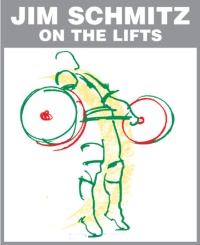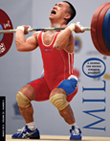Mental Focus

By Jim Schmitz
U.S. Olympic Weightlifting Team Coach 1980, 1988 & 1992
Author of Olympic-style Weightlifting for Beginner & Intermediate Weightlifters Manual and DVD
Mental Focus / Concentration
Mental focus, concentration, and determination all mean the same thing: the ability to totally put your mind to the task you want to accomplish. My last training article was about never giving up, which requires mental commitment for the long term, or seeing the big picture. What I want to address here is the mental concentration required to complete the immediate task at hand and not get distracted. In other words, you need to block out all other thoughts and only think about what you want to do: lift the weight, hit the ball, make the basket, catch the ball, make the tackle, etc.
I first learned about mental focus during my Little League baseball days when my coach said, "You must keep your eyes on the ball at all times." To the better athletes that seemed to come naturally, but I had to really concentrate on watching the ball—whether it was being thrown or had been hit. Later I learned more about focusing from playing linebacker in football, where you either focus on the movement of the ball or other indicators that will tell you where the ball will be going (such as where offensive linemen place their weight—if their weight is back on their legs they are preparing to setup for a pass; if it's more on their hands it means they will be coming forward, which means a running play). In other words, I really had to pay attention to what was going on right then, at that moment.
A weightlifter who really demonstrated mental focus was Al Feuerbach, world champion and world record holder in the shot put and U.S. national weightlifting champion in 1974. Al could be socializing and looking very relaxed when warming up, but when he stepped on the competition platform or into the shot put ring you could really see and sense his change of demeanor. The look on his face became serious, his eyes narrowed, and he would really focus on the barbell or where he wanted to put the shot. At one national competition there were a lot of guys helping Al load his warm-up bar and coaching and encouraging him. Al was fine with all the attention until it came time for his competition attempts; he then asked the guys to back off and let him prepare for his attempts, and he went through an incredible transformation in his facial expression and body language that said, I'm going to give this weight everything I have.
I've had several lifters who really had a difficult time staying focused when going heavy or competing. They either got distracted by the weight, the surroundings, the significance of what making the weight meant, and whether or not it would mean a medal or a record. Also, some are very good in their gyms or local competitions but not good at national and international events. Some dwell on failure. If this is your problem, here are some approaches that will help you. First, you must only think about what you need to do to lift the weight. Second, train in different gyms or with different equipment. Third, compete often and in different venues. Last, learn to block out all distractions, from music to talking to babies crying. Believe it or not, sooner or later a baby will be crying when you are getting ready to lift. I have heard it at local and national meets, and even at the Olympics.
A major aspect of mental focus is visualization—where you see yourself performing the task at hand. I learned about visualization in the 1980s. I already knew about focus, concentration, and determination, but not visualization. Sometime in the 1980s I met a sports psychologist who talked to me about various aspects of psychology in sport. I knew that "psyching up" meant focus, concentration, and believing you could do it, but visualization was new to me. There are two types of visualization: one where you see yourself doing the lift from your own eyes; the other type is where you see yourself doing the lift as if you were watching a video of yourself.
With this sports psychologist's help, we tried visualization techniques with Mario Martinez and Ken Clark. When he explained the technique it was new to Ken, but Mario said that's how he always focused on his lifting. Mario said he always saw himself doing the lift before he did it. Visualization came naturally to him; he had never thought about it and no one had ever told him to do it.
Another great example of focus and concentration is David Rigert, 1976 Olympic champion and many-time world champion, from the former Soviet Untion. I didn't witness this, but I read about it in Strength & Health magazine. David had won the world championships the day before and was in the training hall watching his teammates train. Someone challenged him to lift the 170 kg that was on the bar, so in his street clothes he walked over to the bar, stood over it and began to focus on liftnig it. After several minutes his breathing rate increased, he started to sweat, and his face became taut with a look of determination. He then bent over and grabbed the bar, clean and jerked the 170 kg, and dropped it. Everyone was astounded. Another story about Rigert's great focus was again from the warm-up room where he snatched 130 kg barefoot and in either a Speedo swimsuit or his underwear. There was a picture of that lift in Strength & Health sometime in the 1970s.
The champions all have this great focusing ability—and like any ability, for some it comes naturally and others have to work hard to develop it. Also like any ability, even if it comes naturally, if you don't use it, you lose it.
You develop focus by thinking about what you want to do and what it will take to do it. First, you watch how the lift is to be done; then you do it yourself so you have an idea of what it feels like. You then work on certain aspects of the lift and practice and practice. It's important to be thinking about what you are doing while you are doing it. However, I must warn you to not think too much, because you will develop "paralysis due to analysis"—thinking too much and not moving fast enough. Think about how you are going to lift the weight and then do it, fast. Don't think of too many things, only one or two or three things, tops.
"Grey matter makes the red matter work." That means that your brain makes your muscles work, so think, concentrate, focus, and then do it, fast! It all comes down to blocking out all other thoughts and only thinking about how you are going to lift that weight.
###
For more information on Olympic-style weightlifting, weight training, lifter profiles, and competition reports, visit our Weightlifting Resource Pages.
Jim Schmitz’s gold-medal articles on weightlifting and weight training are regularly featured in MILO: A Journal for Serious Strength Athletes.
Take advantage of what Jim Schmitz, absolutely one of the best American coaches in the sport, can teach you in his Olympic-style Weightlifting for the Beginner & Intermediate Weightlifters Manual and DVD.






